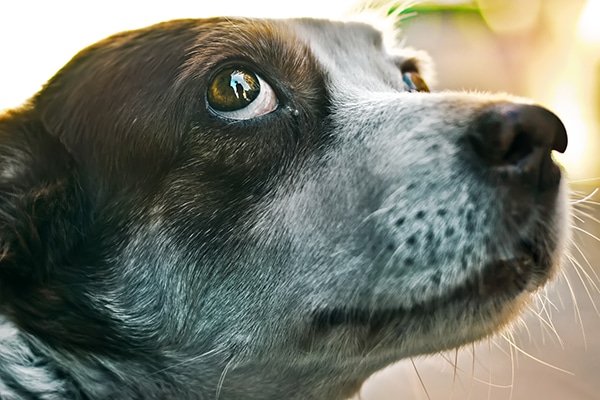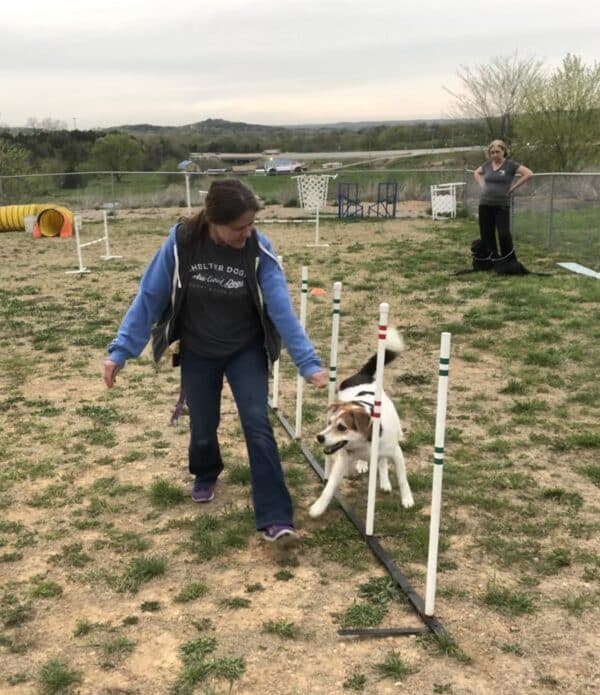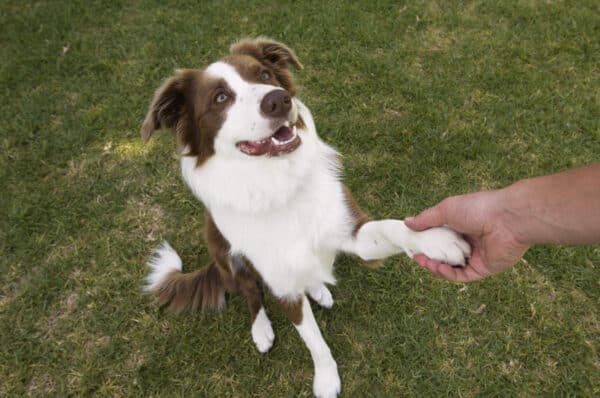Dogs communicate with incredibly subtle body language cues, using their entire bodies to tell us how they’re feeling. So, when you notice your dog displaying wide, bulging eyes that show the whites of his eyes, you’re noticing whale eyes in dogs.
What Are Whale Eyes in Dogs?

One often-missed but very telling body language cue is the whale eye in dogs. When a dog feels frightened or threatened, his eyes widen, exposing the white parts of his eyes (the sclera). It’s not so different from how we humans react to fear: we stiffen and our eyes get real big. When dogs display whale eyes, you may also notice facial tension and a closed mouth. Anyone who sees whale eyes in dogs needs to pay close attention — this dog could bite!
Why Would You See Dog Whale Eye?
Humans will notice the whale eye in dogs if they get frustrated and yell at a dog — or even when training a new task, trick or cue. Whale eyes may even show with something seemingly simple, like grooming or trimming your dog’s nails for the first time.
If you’re rushing the teaching, the dog may easily become confused or fearful. So, if you see the whites of his eyes showing, it’s time to check in with yourself to see what you’ve done to confuse or frighten your dog. Slow down, take a deep breath and start anew. Maybe show him the nail clippers and treat a few times, then just touch his nails with the clippers and treat. The point of doing anything new with a dog, especially a puppy, is to go slowly, paying attention to the dog’s comfort level and adjusting what you’re doing to keep him from becoming stressed or fearful.
Dogs May Give Whale Eyes If a Stranger Hugs Them
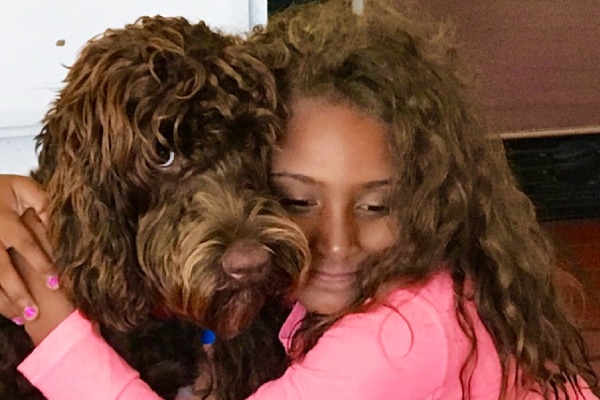
One of my biggest concerns is when a child hugs a dog. Most dogs don’t like being hugged, or held too tightly. If they feel like they don’t have a way out, they could bite.
In the image above, you can see that the dog isn’t very happy about being hugged by this child. If this situation were to continue without interruption (such as an adult asking the child to release the dog), the dog may become so uncomfortable and stressed that he feels he has no way out and therefore bite.
Not All Whale Eyes in Dogs Are Bad
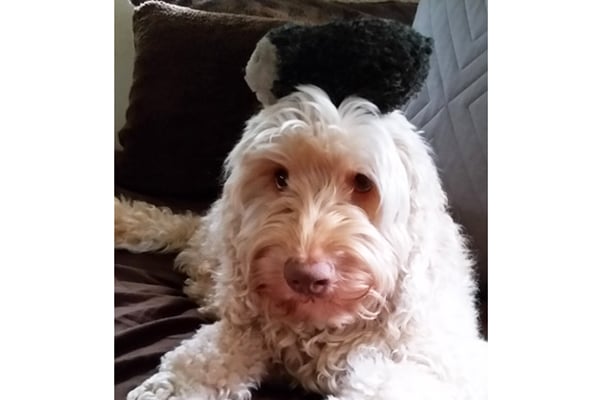
Not all whale eyes in dogs are equal — and not all whale eyes in dogs are bad. Some dogs are masters at not moving their heads, only their eyes. If you have a dog like this, then you have a clown in your home. I know because I have one.
Oscar, my Labradoodle, loves to keep his head still while looking at me by just moving his eyes. I’m sure I reinforced this behavior because it makes me laugh every time he does it. So, for Oscar, when he shows the whites of his eyes, he’s playing and wanting to engage. I’ve taught him some silly tricks that encourage him to show me the whites of his eyes. For example, placing a soft toy on his head and asking him to wait very still before I release him to throw the toy off his head and catch it mid-air. While he’s waiting for me to say “OK,” he’s shifting his eyes back and forth and up and down, with anticipation while exposing the whites of his eyes. We love this game.
How to Tell the Difference Between Fearful Whale Eyes and Playful Whale Eyes
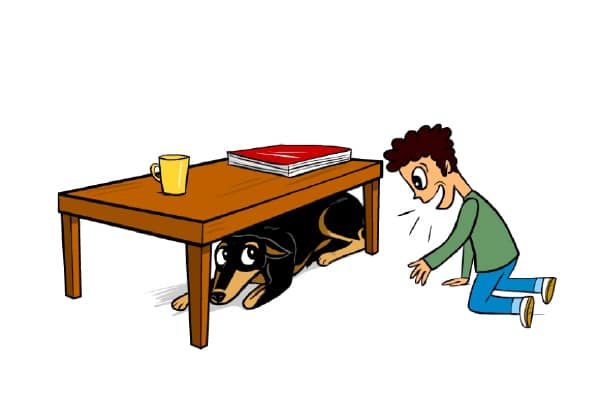
So, how can you tell the difference between a dog who is frightened or a dog who’s playing? Look at all the body parts talking and the context in which it’s happening. Are you playing chase and your dog stops and looks at you without raising his head, showing the whites of his eyes with a tension-free wiggly body, open mouth and almost smiling face? This dog is playful, not frightened.
Here’s another scenario. Let’s say you are upset with your dog because he ate your sandwich that you left in the car while you ran an errand. Now, you are scolding him and the whites of his eyes are showing. This dog is afraid. Remember, punishing a dog for an unwanted behavior will only increase his fear and it won’t stop the behavior. Choose your battles and don’t punish your dog for your mistakes. Teaching dogs what we want them to do instead of punishing them for unwanted behaviors will make for a much more trusting relationship between you and your dog.
Other Ways to Decipher Whale Eyes
Still not sure if the whale eye is playful or fearful? These other body language cues signify that the whale eyes mean your dog is afraid:
- Stiff, tense body
- Ears out, to the side and back
- Closed mouth
- Lip licking or tongue flicking
- Looking away
- Hiding or walking away
- Indirect staring or direct staring
What to Do About Whale Eyes in Dogs
If you even think you see whale eyes, err on the side of caution. Stop what you’re doing, assess the situation and proceed to redirect the dog to something else to alleviate the stress.
If the whale eyes are directed toward a child, tell the child to stop what she is doing and remove the dog from the situation until the dog relaxes or play his favorite game to change the dynamic. Then, please check in to see how you can make changes for the future to keep your dog from being stressed, afraid or uncomfortable. When we humans become more proficient at reading dog body language, our relationships and bonds deepen. After all, isn’t this why we share our lives with dogs?
It’s critical to learn how to read dogs, so we can help them when we see that they are stressed, anxious or uncomfortable in any situation. One of my favorite books, Decoding Your Dog by a group of veterinary behaviorists, describes body language and behaviors in great detail. If you want an on-the-spot reference of dog body language, the Dog Decoder smartphone app, used by veterinarians, educators, trainers, and anyone who loves and cares for dogs is available in iTunes and Google play; ready when you need it. Children love it, too!
Tell us: Have you ever witnessed whale eye in dogs? In what sort of situation?
Learn more about different types of dog facial expressions here >>
Read more about training your dog on Dogster.com:
- Help! My Dog is Scared of Everything
- Teaching Your Dog to Leave It
- How Your Dog Can Pass the Canine Good Citizen Test
Jill Breitner is a professional dog trainer, award-winning writer and dog body language expert, loving and living her life on the west coast, USA. She is the author of Dog Decoder, a smartphone app about dog body language. Jill has been teaching gentle handling/basic husbandry skills to clients and their dogs for 40 years, to be your pet’s advocate for a happier and stress-free life. Join Jill on her Dog Decoder Facebook page.
Featured Image Credit: sadetgr | iStock / Getty Images Plus.

